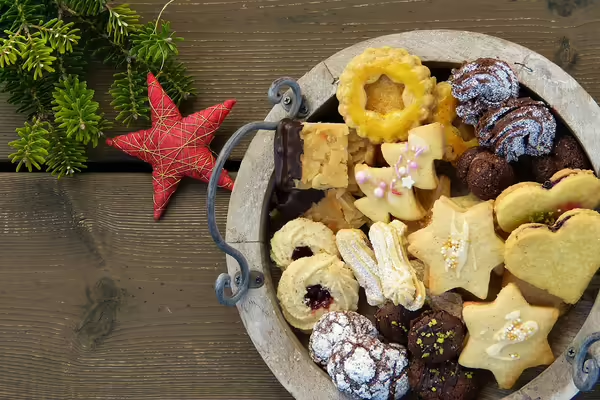
URBANA, Ill. — Sugar and spice make everything nice, especially in holiday treats. But do you know where sugar and spice come from?
Plants make the sugar glucose during the process of photosynthesis. Certain plants can take excess glucose, create sucrose, and then store it in either the stalk or root. This becomes the sugar used every day to sweeten everything from coffee to cookies. Sugar adds sweetness, gives a tender texture, and allows browning to occur in baked goods.
The sugar comes from two different plants: sugarcane and sugar beets. The U.S. is one of the largest sugar producers in the world due to its well-developed sugar cane and sugar beet industries. Worldwide, 70% of sugar comes from sugarcane. Sugarcane is a tall grass that grows in tropical areas. In a tropical setting like Hawaii, it grows in fields and looks similar to corn. Florida is the largest producer of sugarcane in the U.S.
Making Sugar
To get sugar from sugarcane, the cane is pressed to extract the juice, then boiled and spun to produce raw sugar and syrup or molasses. The raw sugar is then sent to a refinery where it is washed and filtered to remove remaining non-sugar ingredients and color. It is then crystallized, dried, and packaged into refined or granulated sugar.
Most of the sugar used in Illinois probably comes from sugar beets. Sugar beets are a root crop resembling a large parsnip grown mostly in the temperate zones of the north. Beets are harvested after the temperature drops to preserve the high sugar levels until processing.
Beet sugar processing is similar to sugarcane, but it is done in one continuous process without the raw sugar stage. The sugar beets are washed, sliced, and soaked in hot water to separate the sugar-containing juice from the beet fiber. The sugar-laden juice is purified, filtered, concentrated, and dried.
Spicing Things Up
During the holidays, the most used spices are native to the tropics, and many come from trees. In the Caribbean, there are plants that produce allspice, cinnamon, ginger, and nutmeg.
Allspice, grown on the pimento tree (Pimenta dioica) and part of the family Myrtaceae, is native to Jamaica. The dried berries taste like a combination of nutmeg, cinnamon, and cloves with a peppery heat.
Cinnamon comes from the inner bark of tropical cinnamon trees (Cinnamomum zeylanicum). These are small trees from the laurel family that grow about 30 feet tall and are native to Southwest India.
Nutmeg (Myristica fragrans) trees are the only tropical fruit that is the source of two different spices obtained from different parts of the plant. Nutmeg is the seed of the tree's fruit, and mace is the seed's veil-like covering.
Ginger is an herbaceous perennial plant with a beautiful flower. It has a knobby, bumpy root with a peppery yet slightly sweet flavor. The tropical spice ginger (Zingiber officinale) is different from native ginger (Asarum canadense).
Vanilla (Vanilla planifolia Andrews) is the only crop from the Orchidaceae (orchid) family. The time and labor that is invested in producing vanilla makes it one of the most expensive spices for holiday treats.
Peppermint (Mentha piperita L.) flavors many holiday candies and goodies, such as the candy cane. The pungent fragrance comes from the leaves that have had lots of time in the sunlight. True peppermint is almost exclusively used in confectionary treats. Its cooling freshness pairs well with chocolate and is also used to balance the sweetness of sugar.
The next time you enjoy sugar and spice and everything nice, think of the tropical plants that produce these crops. For questions, connect with a location University of Illinois Extension office from the map.
Nicole Flowers-Kimmerle is an Illinois Extension horticulture educator for Fulton, Mason, Peoria, and Tazewell counties. Gardeners Corner is a quarterly newsletter from gardening experts around the state. Each issue highlights best practices that will make your houseplants, landscape, or garden shine in any season. Join the Gardener’s Corner email list at subscribe for direct access to timely tips.
Photo Caption: Breaking down the processes of sugar and spices just adds to the delicious flavors of holiday baking. Photo by Silvia via Pixabay.
University of Illinois Extension develops educational programs, extends knowledge, and builds partnerships to support people, communities, and their environments as part of the state's land-grant institution. Extension serves as the leading public outreach effort for University of Illinois Urbana-Champaign and the College of Agricultural, Consumer and Environmental Sciences in all 102 Illinois counties through a network of 27 multi-county units and over 700 staff statewide. Extension’s mission is responsive to eight strategic priorities — community, economy, environment, food and agriculture, health, partnerships, technology and discovery, and workforce excellence — that are served through six program areas — 4-H youth development, agriculture and agribusiness, community and economic development, family and consumer science, integrated health disparities, and natural resources, environment, and energy.